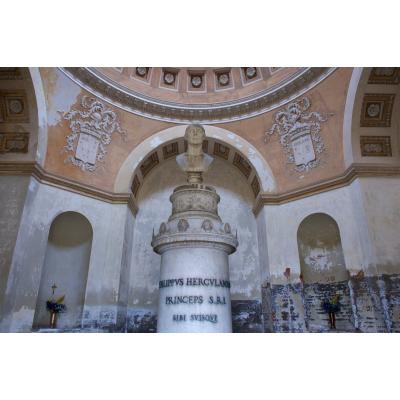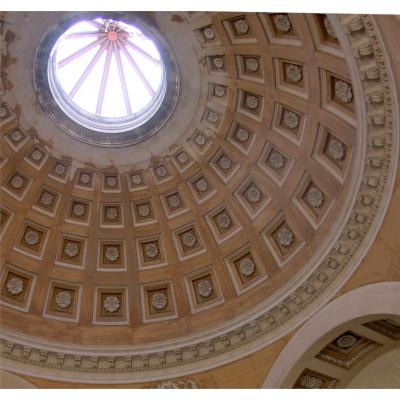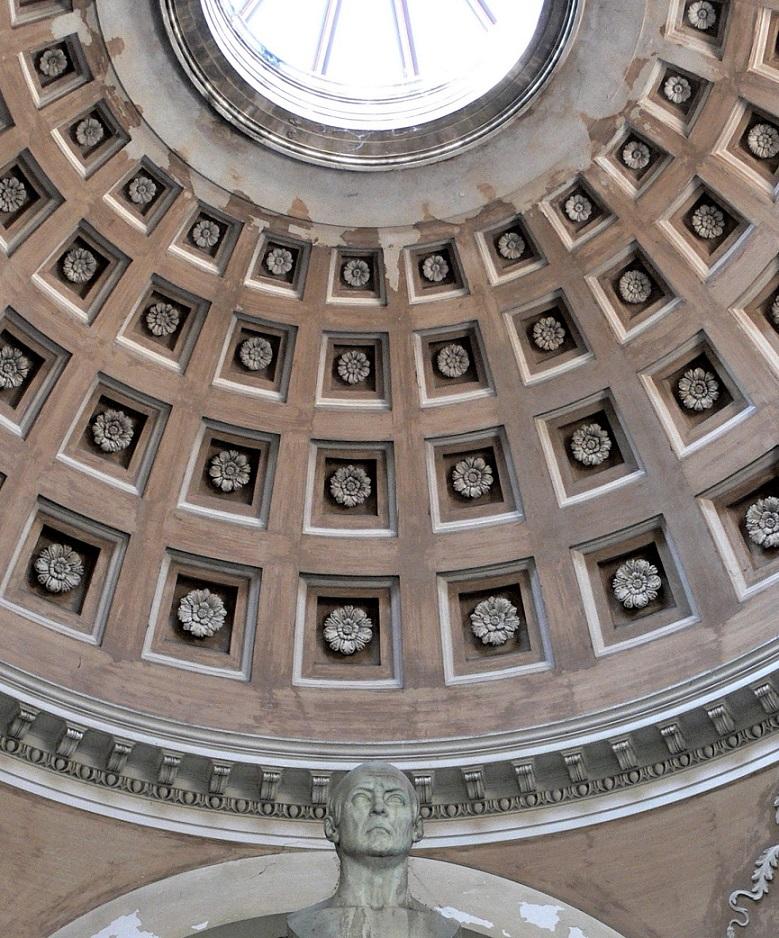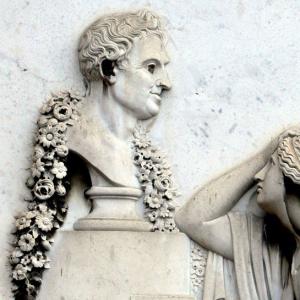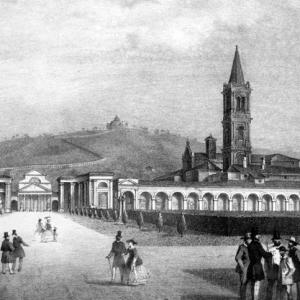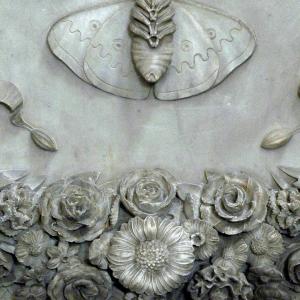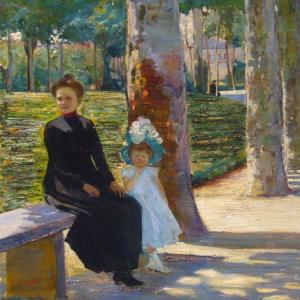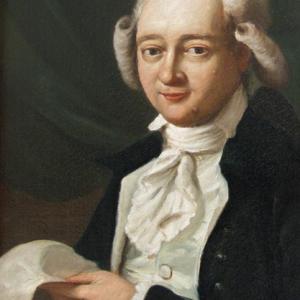Schede
The project for the imposing chapel, inspired by classical models such as the Pantheon in Rome, was entrusted to the architect Angelo Venturoli (1749 - 1821), who in 1793 had also been entrusted with the extension of the family palace in Strada Maggiore, now housing a faculty of the University of Bologna. The 16th century style palace contains interesting artistic, sculptural and pictorial works by many artists, including Giacomo De Maria, Jacopo Alessandro Calvi, Filippo Pedrini, Flaminio Minozzi, Serafino Barozzi, Gianbattista Frulli, Luigi Buratti, Pietro and Petronio Fancelli, Antonio Basoli, Rodolfo Fantuzzi, Gaetano and Giuseppe Caponeri and Gian Battista Sangiorgi, almost all of whom worked in the cemetery for various families. Prince Filippo Hercolani, who died in 1810, is depicted at the centre of the chapel above a high memorial stone with a colossal marble sculpture by Cincinnato Baruzzi (1790 - 1878). Four large heraldic coats of arms in bipartite stucco appear in the splays at the base of the dome: to the left the heraldic symbol of the Hercolani, and to the right that of the families to whom they were related.
Sara Benuzzi
The immense wealth of artworks in Bologna Certosa is rich in heraldic artefacts, which reveal the names of the families and individuals resting here by means of the symbols and very unusual iconography of this documentary science. To know and understand heraldry, you just have to begin by looking carefully and with a few simple notions at the many coats of arms here. In most cases they are inside a chapel, identifying the family or person buried there, with epigraphs that usually give the names and surnames of the deceased. The same coats of arms can easily be found in many other places in the city: on ancient palaces and monuments, in churches, on the walls of the Archiginnasio, in museums, and also in material kept in libraries, such as crests and numerous historical documents. It may be hard to recognise or attribute a heraldic artefact because most coats of arms in Certosa lack colour, but in appearance only, because in many cases colours are present in the form of the “traditional hatches” typical of heraldry. Sometimes two or more coats of arms can be seen in the same context: this is often the heraldic representation of both spouses or of a family whose members have adopted different coats of arms, but the identification or attribution of a heraldic artefact is particularly difficult in the absence of epigraphs.
We shall analyse the case of the Hercolani Chapel to describe these difficulties and the methodology that can be adopted to answer such questions. Prince Filippo Hercolani entrusted its design to the architect Angelo Venturoli, whom he had also commissioned to transform the family palace. The walls of this Chapel have four large stucco coats of arms, each of which is “partitioned,” i.e., vertically divided in half: the Hercolani family coat of arms is represented on the heraldic right (the viewer’s left) but who does the other half belong to? Without epigraphs, how can we trace the owners of these coats of arms? The answer can be found with genealogical reconstruction.
Filippo Hercolani was the son of Marco Antonio († 1772), Patrician of Bologna, of the Magistrate of Elders in 1745, 3rd Prince of the H.R.E., Count Palatino and Marquis of Blumberg, titles renewed and transferred to his line in 1765. In 1727 he married Silvia Barbazza, daughter of Marquis Giovanni Antonio, Patrician of Bologna († 1783). HERCOLANI coat of arms: Field of azure and or, at the stripe of the first, charged with three crowns of the second, all crossed; with the head of Anjou. This is the blazon of the Hercolani coat of arms, described in the rather special language of heraldry. “Translating”, we can say that the shield is vertically divided into six parts, with alternating blue and yellow (gold) colours, always starting from the heraldic right, superimposed with an oblique blue band with three gold crowns. The “head of Anjou”, which is very common in Bolognese coats of arms as a sign of belonging to the Guelph part and dating back to Charles of Anjou, occupies the upper third of the shield and shows its blue colour with three gold lilies placed between four pendants of a red lambel (a heraldic figure similar to a rake).
Filippo Astorre Hercolani (1736 † 1810), 4th Prince of the H.R.E. and Count Palatino, Marquis of Blumberg and Patrician of Bologna; Senator in 1775, Imperial Chamberlain, had Villa Belpoggio built near Bologna. In 1774 he married Corona Maria Anna Cavriani (1751 † 1830), daughter of Marquis Ferdinando and Maria Rosa Bentivoglio d’Aragona of the Marquises of Gualtieri. CAVRIANI coat of arms: Quartered: in the 1st and 4th of argent, and three black bands; in the 2nd and 3rd of argent, with black double-headed eagle, crowned or; with a red Maltese cross at the extremity, crossing the partition. Indeed, half of one of the coats of arms corresponds to this description.
Their son Astorre Enrico (1779 † 1829), 5th Prince of the H.R.E. and Count Palatino, Marquis of Blumberg, Patrician of Bologna, made Count of the Kingdom of Italy in 1810, in 1798 married Maria Malvezzi, (1780 † 1865), daughter of Piriteo Marquis of Castelguelfo, Patrician of Bologna, and Anna Maria of the Marquises Malvezzi Angelelli Lady of the Vicereine of Italy until 1814. MALVEZZI coat of arms: Azure, with or band, crossed at the heart by a shield of the same, charged with a black eagle, crowned, rostrata and membred or; with the head of Anjou.
Half of another of the coats of arms corresponds to this description. Let us conclude this analysis with another equally emblematic case provided by another of the coats of arms in the Hercolani Chapel. Count Don Filippo (1811 † 1847), Patrician of Bologna, married twice: in 1830 to Donna Luigia Pallavicini, (1811 † 1835) daughter of Marquis Don Pietro Ercole 1st Prince Pallavicini and Noblewoman Maria Gradenigo, Venetian Patrician. Widowed, in 1836 he married Teresa Maria Luigia Carolina Anna Malvezzi Angelelli (1820 † 1897), daughter of Marquis Massimiliano Francesco, Patrician of Bologna, and Ippolita of the Counts Bentivoglio. One of the coats of arms is indeed semi truncate partitioned with the coats of arms of the two wives i.e. in addition to being divided vertically, in the left part (right for the observer) it is also divided horizontally with the Pallavicini coat of arms above and that of the Angelelli below. PALLAVICINI coat of arms: Five or spots, corresponding to four argent; with or head, charged with a black fence. ANGELELLI coat of arms: Azure, with griffin rampant or, with a red border, charged with 14 peacock feathers au naturel.
Maria Cristina Sintoni
Bibliography: F. Canetoli, Blasone Bolognese, ovvero Arme gentilizie di famiglie bolognesi nobili, cittadinesche e aggregate, Bologna, 1791-1795; IAGI Istituto Araldico Genealogico Italiano; V. Spreti, Enciclopedia Storico-Nobiliare Italiana, Milan, Enciclopedia Storico Nobiliare italiana, 1928-35; G. B. Di Crollalanza, Dizionario Storico-Blasonico, Pisa, presso la Direzione del Giornale Araldico, 1886-1890


